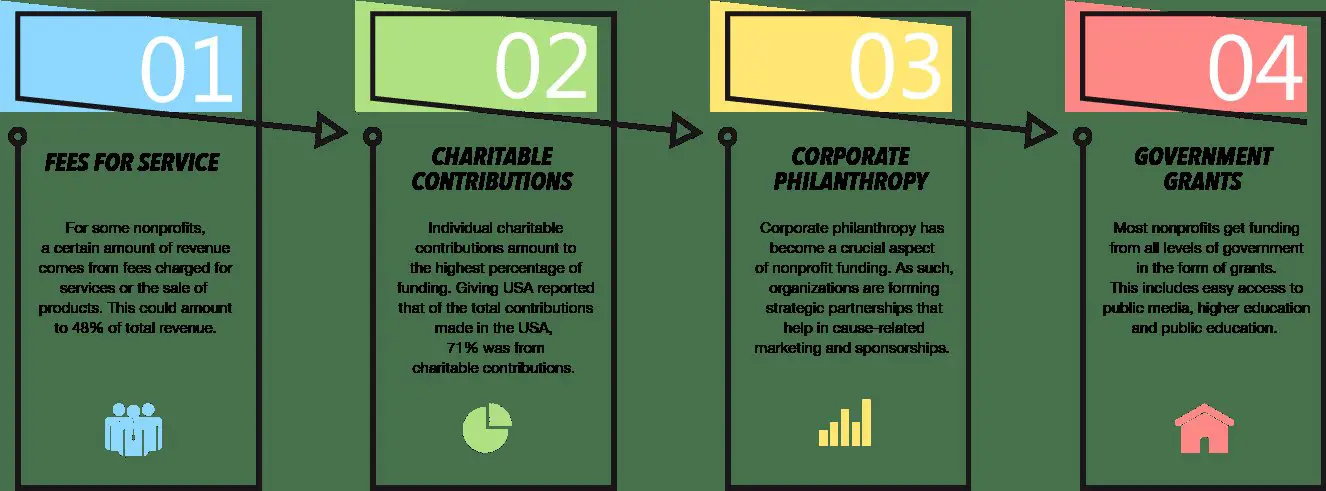Looking for ways to secure grants for nonprofit organizations? You’ve come to the right place! In this article, we will explore effective strategies that can help your organization successfully obtain grants to support your important work. Whether you are new to the world of grant funding or looking to enhance your existing approach, we’ve got you covered. Discover the key steps, tips, and best practices on how to get grants for nonprofit organizations. Let’s dive in and unlock the secrets to securing vital funding for your cause.
How to Get Grants for Nonprofit Organizations
Introduction
Nonprofit organizations play a crucial role in addressing societal challenges, from providing education and healthcare to supporting vulnerable communities and advocating for human rights. However, funding these organizations and their initiatives can be a major hurdle. One powerful solution to overcome this obstacle is securing grants. Grants are financial support provided by various foundations, government agencies, and corporations to propel the work of nonprofit organizations and enable them to make a positive impact on the world.
In this comprehensive guide, we will dive into the world of grants for nonprofit organizations. We will explore step-by-step strategies, practical tips, and insider insights on how to effectively obtain grants that align with your organization’s mission and goals. Whether you’re a well-established nonprofit looking to expand your reach or a new organization eager to make a difference, this guide will equip you with the knowledge and tools necessary to navigate the grant-seeking process successfully.
1. Identify Your Organization’s Funding Needs and Goals
Before embarking on the search for grants, it is essential to clearly outline your organization’s funding needs and goals. Taking the time to define your financial requirements and the specific projects or initiatives you aim to fund will help streamline your grant-seeking efforts. Here are some key steps to follow:
1.1 Assess Your Current Financial Status
Conduct an in-depth assessment of your organization’s current financial status. Determine how much funding you need, what resources you already have, and where the gaps exist. This evaluation will enable you to identify the specific areas that require support and guide your search for grants that align with your needs.
1.2 Define Your Organization’s Goals
Clearly articulate what your organization aims to achieve through its initiatives and projects. Define the measurable goals you want to accomplish and the specific outcomes you hope to deliver. Understanding your organization’s goals will help you identify grants that are a good fit and effectively communicate your mission to potential funders.
1.3 Create a Budget
Develop a detailed budget that outlines the financial requirements of your initiatives. Break down the costs associated with each project, including personnel, supplies, equipment, and any other relevant expenses. A well-prepared budget will demonstrate your organization’s financial needs to potential funders and showcase your commitment to responsible financial management.
2. Research Grant Opportunities
Once you have clarified your organization’s funding needs and goals, the next step is to conduct thorough research to identify suitable grant opportunities. This process involves exploring different types of funding sources, understanding their priorities, and determining if they align with your organization’s mission. Here’s how you can conduct effective grant research:
2.1 Grant Databases and Online Resources
Utilize grant databases and online platforms dedicated to listing available grants for nonprofit organizations. Websites like GrantWatch, GrantStation, and Foundation Directory Online provide comprehensive databases that allow you to filter grants based on specific criteria such as focus area, geographic location, and organizational size. These platforms simplify the exploration process and save you time.
2.2 Foundation Websites
Visit the websites of foundations and organizations directly to understand their funding priorities and guidelines. Many foundations have dedicated sections on their websites providing information about their grant programs, application procedures, and past grantees. By reviewing this information, you can assess whether your organization aligns with the foundation’s mission and tailor your grant proposal accordingly.
2.3 Government Grants
Explore government agencies at the local, state, and federal levels that offer grants to nonprofit organizations. Visit their websites or contact their grant offices for information on available funding opportunities. Government grants can be an excellent source of funding, particularly for organizations focusing on areas such as education, healthcare, and social services.
2.4 Networking and Professional Associations
Engage with your professional network and reach out to local and national associations relevant to your organization’s mission. Attend conferences, webinars, and workshops where you can connect with like-minded individuals and potential funders. These networking opportunities can provide valuable insights into available grants and establish relationships that may lead to funding opportunities.
3. Craft an Effective Grant Proposal
Once you have identified potential grant opportunities, the next crucial step is to create a compelling grant proposal. A well-crafted proposal is essential to capture the attention of funders and secure the financial support you need. Consider the following elements when developing your grant proposal:
3.1 Introduction
Begin your grant proposal with a concise and engaging introduction that clearly defines your organization’s mission and the project or initiative you are seeking funding for. Hook the reader’s attention by highlighting the significance of the issue your organization aims to address and the potential impact of your proposed solution.
3.2 Problem Statement
Clearly articulate the problem or need that your organization aims to tackle. Provide evidence-backed statistics, case studies, or testimonials to demonstrate the magnitude and urgency of the issue. Create a compelling narrative that resonates with the funder and highlights the relevance of your organization’s work.
3.3 Goals and Objectives
Outline the specific goals and objectives of your project or initiative. Make sure they are measurable, achievable, and aligned with your organization’s overall mission. Clearly communicate how the requested grant will help your organization achieve these goals and contribute to the broader cause.
3.4 Methodology and Approach
Describe the methodology and approach you will employ to address the identified problem and achieve your goals. Explain the activities, strategies, and resources you will utilize. Provide a detailed timeline, showcasing your organization’s ability to execute the project effectively and efficiently.
3.5 Budget and Financial Management
Include a comprehensive budget that outlines the financial requirements of your project or initiative. Break down the costs in a clear and transparent manner, ensuring that each expense is justified and aligned with the proposed activities. Clearly demonstrate your organization’s fiscal responsibility and the impact the grant will have on your financial sustainability.
3.6 Evaluation and Measurement
Highlight the evaluation methods and metrics you will employ to measure the success of your project or initiative. Showing a strong commitment to transparency and accountability will inspire confidence in funders and increase the likelihood of securing the grant. Discuss how you will collect data, monitor progress, and assess the impact of your work.
4. Submitting the Grant Application
Once you have finalized your grant proposal, it’s time to prepare and submit the grant application. Pay careful attention to the application guidelines provided by the funding source and ensure that you meet all the requirements. Here are some key steps to follow:
4.1 Review Application Guidelines
Thoroughly review and understand the application guidelines provided by the funding source. Pay attention to deadlines, required documentation, formatting requirements, and any specific instructions. Failing to adhere to the guidelines may result in your application being disqualified.
4.2 Gather Required Documentation
Collect all the necessary documentation required for the grant application. This may include financial statements, tax-exempt status verification, letters of support, resumes of key staff members, and any other supporting materials specified in the application guidelines. Prepare and organize these documents well in advance to ensure a smooth application process.
4.3 Follow Formatting and Submission Guidelines
Format your grant application according to the specified guidelines. Use clear, concise language, and ensure that all sections of the application are complete. If electronic submission is required, make sure to upload all the necessary documents in the prescribed format. If a hard copy submission is required, assemble all the materials neatly and securely.
4.4 Proofread and Seek Feedback
Thoroughly proofread your grant application for grammatical errors, typos, and clarity. Consider seeking feedback from colleagues, mentors, or professionals experienced in grant writing. Fresh eyes can identify potential areas of improvement and provide valuable suggestions.
5. Follow-Up and Relationship Building
After submitting your grant application, it’s crucial to follow up and build relationships with funders. Cultivating these connections can increase your chances of securing grants in the future. Here are some important steps to take:
5.1 Acknowledge Receipt
Once you have submitted your grant application, send a brief thank-you email to the funding source. Express your gratitude for the opportunity and reiterate your organization’s commitment to the cause. This simple gesture demonstrates professionalism and builds a positive rapport.
5.2 Provide Updates and Progress Reports
If you receive a grant award, promptly acknowledge the funding and provide regular updates to the funder. Detail how the funds are being utilized, share key milestones achieved, and highlight the impact of the project. Regular communication enhances transparency and fosters trust between your organization and the funder.
5.3 Express Gratitude
Remember to express your gratitude to the funders for their support. Send personalized thank-you notes, share success stories, or invite them to events hosted by your organization. Building strong, lasting relationships with funders can open doors for future funding opportunities.
Conclusion
Securing grants for nonprofit organizations is a dynamic and complex process. However, with careful preparation, diligent research, effective grant writing, and relationship-building, your organization can increase its chances of obtaining the necessary funding to fulfill its mission and make a significant impact. By following the steps outlined in this guide, you are empowered to navigate the grant-seeking journey and unlock new opportunities for your nonprofit organization’s growth and success. Good luck in your grant-seeking endeavors!
6 Types of Grants for Nonprofits (and how to find them)
Frequently Asked Questions
Frequently Asked Questions (FAQs)
How can nonprofit organizations obtain grants?
Nonprofit organizations can obtain grants through various channels such as government agencies, foundations, corporations, and private donors. It involves researching grant opportunities, preparing grant proposals, and submitting applications that align with the organization’s mission and goals.
What are the key steps in the grant application process?
The grant application process typically involves the following steps:
1. Research: Identify potential grant opportunities that match the organization’s mission and objectives.
2. Prepare: Gather the necessary documents, including financial statements, program plans, and supporting data.
3. Write the Proposal: Craft a compelling grant proposal that clearly presents the organization’s purpose, goals, and intended use of funds.
4. Review and Edit: Ensure the proposal is well-written, concise, and addresses all requirements specified in the grant guidelines.
5. Submit: Submit the grant application within the designated deadline, following the submission instructions provided by the funding source.
How can nonprofits find relevant grant opportunities?
Nonprofits can find grant opportunities through multiple avenues:
1. Online Research: Utilize grant databases and search engines specifically designed to connect organizations with relevant funding opportunities.
2. Networking: Attend conferences, workshops, and events within the nonprofit sector to build connections and gain insights on available grants.
3. Professional Associations: Joining professional associations related to the nonprofit’s field can provide access to grant opportunities and resources tailored to specific sectors.
What information should be included in a grant proposal?
A grant proposal should include essential information such as:
1. Executive Summary: Briefly describe the organization, its mission, and the purpose of the proposed project.
2. Need Statement: Clearly articulate the issue or problem the project aims to address and demonstrate its relevance and significance.
3. Goals and Objectives: Clearly define the project’s goals and the specific, measurable objectives that will be achieved.
4. Methodology: Explain how the project will be implemented, including the strategies, activities, and timelines.
5. Budget: Provide a detailed budget that outlines the estimated costs of the project and how grant funds will be allocated.
6. Evaluation Plan: Describe how the project’s success will be measured and evaluated.
Are there any common mistakes to avoid when applying for grants?
Yes, there are a few common mistakes nonprofit organizations should avoid when applying for grants, including:
1. Failing to read and follow the grant guidelines and instructions.
2. Submitting incomplete proposals or missing required supporting documents.
3. Writing a generic proposal that does not specifically address the funder’s priorities or requirements.
4. Neglecting to tailor the proposal to the funder’s mission and goals.
5. Submitting the application after the deadline.
6. Failing to adequately proofread and edit the proposal for grammar, spelling, and clarity.
What is the typical timeframe for hearing back on a grant application?
The timeframe for hearing back on a grant application varies depending on the funding source. It can range from a few weeks to several months. Some grantors may provide estimated timelines within their application guidelines, while others may not. It is best to be patient and follow up with the funder if no response has been received within a reasonable timeframe.
What can nonprofits do if their grant application is not approved?
If a grant application is not approved, nonprofits can take the following actions:
1. Seek Feedback: Reach out to the funder and request feedback on the proposal. This can provide valuable insights on areas for improvement.
2. Revise the Proposal: Incorporate the feedback received and make necessary improvements to the proposal before resubmitting it to other potential funders.
3. Diversify Funding Sources: Explore alternative funding options, such as crowdfunding, individual donations, corporate sponsorships, or collaborating with other organizations on joint grant proposals.
Is it possible for nonprofit organizations to receive multiple grants?
Yes, nonprofit organizations can receive multiple grants from different funding sources. However, it is important to ensure that the organization can effectively manage the requirements and reporting obligations associated with each grant received. It is advisable to have a solid grants management system in place to keep track of deadlines, reporting requirements, and the overall impact of each grant-funded project.
Final Thoughts
Getting grants for nonprofit organizations can be a crucial step in securing the necessary funding for your mission. Start by identifying potential grant opportunities that align with your organization’s goals. Research and understand the eligibility criteria and application process for each grant. Craft a compelling proposal that clearly communicates your organization’s impact and objectives. Engage with funders and build relationships to increase your chances of success. Lastly, ensure proper documentation and follow-up to maintain transparency and accountability. By following these steps, your nonprofit organization can effectively pursue and secure grants to support its initiatives. Remember, seeking grants for nonprofit organizations requires thorough research, strategic planning, and effective communication.


